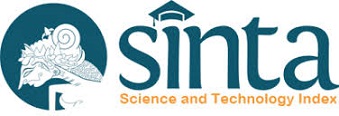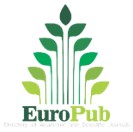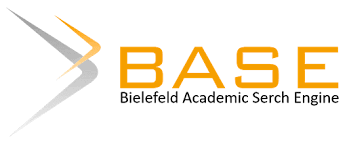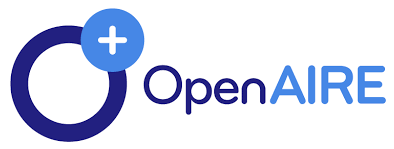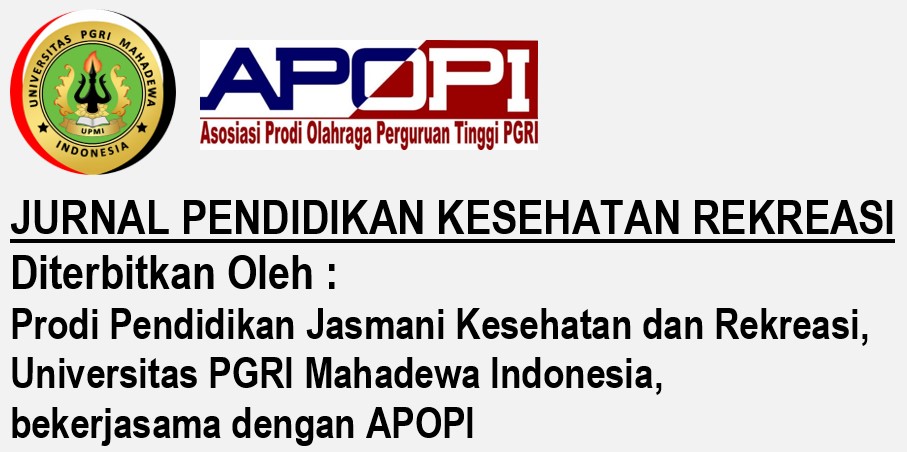Author Guidelines
- Manuscript Writing Guidelines
- Contains scientific texts in the field of sports and health with studies on sports and health education issues.
- Using the example script ( Journal template ) which has been provided on the right sidebar of this website.
- Manuscripts are written in standard Indonesian according to enhanced spelling and/or standard English.
- Writing of research results, theoretical studies and application of theory. Manuscripts must be original (never been published) and written by researchers and research teams using Indonesian or English. Scientific papers that have been presented at national and international scientific meetings should be accompanied by footnotes.
- The manuscript is made on A4 size paper, typed with double spacing using the word processing program Microsoft Word, Times New Roman font.
- The procedure for writing research results should be arranged in the following order: Title, Author Identity, Abstract, Introduction, Research Methods, Results and Discussion, Conclusions and suggestions, and Reference List. Strive for the entire manuscript to be no more than 6-20 pages.
- Title : Short and clear (no more than 25 words), written in capital and small letters.
- Author Identity: Name written in full (not abbreviated) without title. If the address of the author's institution is different, then behind each name is an index of Arabic numerals. The author's address is written under the author's name, including the laboratory, institution, and complete address with telephone/facsimile number and e-mail. An additional index is given to the corresponding author ( corresponding author ).
- Abstract: Written in Indonesian and English, if the text is in Indonesian, and vice versa. The abstract is accompanied by keywords ( key words ) which are sorted by importance. Abstract contains a summary of the manuscript, covering the entire writing without trying to detail each part. Avoid using abbreviations. Only English abstracts will be loaded.
- Introduction: Contains the scope, background, objectives and benefits of the research. This section should present the background so that readers can understand and evaluate the research results without reading previous reports related to the topic. Take advantage of the literature that can support the discussion.
- Research Methods: It should be described in detail and clearly regarding the materials used and the way the work is carried out, including statistical methods. The method of work presented should contain sufficient information to enable the research to be repeated successfully.
- Results and Discussion: Presented together and clearly discussing the results of the research. Can be presented in written form in text, tables, or pictures. Reduce the use of graphics if they can be explained in the text. Limit the use of photos, present photos that clearly illustrate the results obtained. Figures and tables must be numbered and cited in the text. Photos can be sent in 4R size. The cost of loading a color photo will be charged to the author. Graphs of data processing results are sent in files that are separate from scientific paper files and are accompanied by program names and basic data for graphing. The discussion presented should contain interpretations of the results obtained and discussions relating to previous research reports. It would be better if the reference used comes from the Journal. Avoid repeating statements that have been submitted on methods, results and other information that has been presented in the introduction.
- Conclusions and Suggestions: Presented separately from the results and discussion.
- Acknowledgments: Can be presented when deemed necessary. Addressed to those who fund research and to give awards to institutions and individuals who have assisted research or the process of scientific writing.
- Bibliography: Arranged alphabetically by name and year of publication. Abbreviations for magazines/journals based on the procedures used by each journal. Reference list of scientific journals/magazines (last 10 years) at least 80% and text books 20%. Use the Mendeley application to help write citation formats.
- All manuscripts were reviewed by double blind review by bestari partners (reviewers) appointed by the editor according to their field of expertise and manuscripts have met the tolerance limit for the percentage of plagiarism with online documents < = 20%. Manuscript writers are given the opportunity to make improvements (revisions) to the manuscript on the basis of recommendations/suggestions from bestari partners and implementing editors. Confirmation of loading or rejection of the manuscript will be notified in writing via email.
- Everything related to the licensing of quoting or the use of computer software for making manuscripts or other matters related to intellectual property rights carried out by the scriptwriters, along with the legal consequences that may arise because of this, is the full responsibility of the scriptwriters.
- Manuscripts that have been published in the Journal of Recreational Health Education can be directly accessed online without carrying out the registration process.
- Reference List Guidelines
reference management applications , one of which is Mendeley . Sources are written following the procedures ( style ) issued by the APA ( American Psychological Association 6th edition ). An example of writing a reference list is as follows.
Book
Johnson, M. (1998). Diabetes: Treatment And Prevention . (JF Manulang, Ed.). Bandung: Indonesia Publishing House.
Arikunto, S. (2015). Classroom Action Research (Revised Ed.). Jakarta: Earth Script.
Print Journal Articles
Setyowati, D., & Widana, IW (2016). The Influence of Interest, Self-Confidence, and Learning Creativity on Mathematics Learning Outcomes. Goldscience , 5 (1), 66–72.
Adnan, Z., Abdullah, HS, Ahmad, J., & Johari, J. (2017). Unveiling the Incidence of Interfirm Collaboration : Evidence from Research and Development Companies in Malaysia. Gadjah Mada International Journal of Business , 19 (2), 123–144.
Online Journal Articles
Ariani, P., & Widana, I. (2017). THE EFFECT OF STRAW SOAT WATER ON OVITRAP ON THE NUMBER OF DENGUE FEVER MOSQUITO (Aedes sp) EGG TRAPED. Goldscience, 5 (1), 8-12. Retrieved from http://ojs.ikippgribali.ac.id/index.php/emasains/article/view/13
Dewi, I. (2015). ABUSE OF PROHIBITED SUBSTANCES (DOPING AND DRUGS) AS AN EFFORT TO INCREASING STAMINA IN SPORTS. Journal of Recreational Health Education, 1 (1), 15-19. Retrieved from http://ojs.ikippgribali.ac.id/index.php/jpkr/article/view/3
Website
Prime, KP (2013). Identification of Information Sources. Retrieved October 16, 2017, from http://lontar.ui.ac.id/il/2source.jsp?hal=1
- Manuscript Submission Guidelines
- Manuscripts are submitted via the Make a Submissions link on the right sidebar of this website by registering as a user first (if not already registered). If already registered, please log in to start submitting the manuscript.
- We do not serve manuscripts sent via email, for those who are beginners in operating the Open Journal System (OJS) application, please see the OJS 3 Learning page .
- Authors are expected to include a short Curriculum Vitae and a clear address.
- Confirmation notification is loaded or not done via email.













